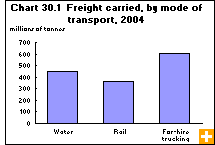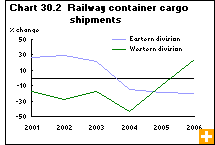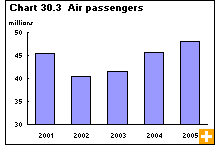Common menu bar links
Transportation
Archived Content
Information identified as archived is provided for reference, research or recordkeeping purposes. It is not subject to the Government of Canada Web Standards and has not been altered or updated since it was archived. Please contact us to request a format other than those available.
Canada is a large country geographically, has a wealth of natural resources and is highly urbanized. So Canadians must rely on many modes of transportation to ship raw materials and finished goods around the country and to markets abroad.
Our system has more than 1.4 million kilometres of roads, 10 major international airports, 300 smaller airports, 72,093 kilometres of functioning railroad track, and more than 300 commercial ports and harbours that provide access to three oceans, the Great Lakes and the St. Lawrence Seaway.
Despite a jump in fuel prices in 2005, demand for transportation services in Canada increased. A strong economy prompted a recovery of trucking and rail in 2004. Air transportation turned around in 2005, following three consecutive years of decline after the attacks of September 11, 2001.
Shipments from overseas have also played a role in boosting the transportation industry. Port activity surged in 2004 thanks to increased demand for goods, particularly for products made in Asia.
Trucking makes gains
A healthy economy and higher wholesale and retail sales drove the demand for trucking services in 2005, which grew despite rising fuel costs. More than one-third of the gross domestic product (GDP) generated by transportation in 2005 came from trucking.
Trucking of goods within provinces accounted for more than two-thirds of the trucking industry’s growth in 2005 and more than half its growth since 2002. From 1990 to 2003, the amount of freight carried by for-hire trucking grew nearly three times faster than that carried by all other transportation modes combined.
For-hire trucking contributed most of the growth in 2005, generating $27 billion in revenues. From 2002 to 2005, for-hire trucking companies based in Canada saw their revenues increase an average 9.8% a year. During that same period, manufacturing output increased 3.6%, wholesale trade, 4.7% and retail trade, 4.8%.
In 2005, fuel made up 11.6% of total operating expenditures, only a slight increase compared with 2004. However, the fleet owners’ most costly expenditure was labour.
Rail loads increase
The rail industry posted gains for a second consecutive year in 2005, moving the largest total freight tonnage since 2000. Rising demand in Canada for manufactured goods from China and other Asian countries increased the tonnage carried by rail from Canada’s ports.
Export shipments of lumber, iron ore concentrates and coal rose, whereas wheat and potash shipments fell. In 2005, railways loaded more than 288.6 million tonnes of goods, an increase of 3.6% or 10.1 million tonnes compared with 2004.
Western Canada’s containerized cargo shipments rose faster than those of the provinces east of Manitoba, due in part to growing shipments to and from the Far East.
Ports are booming
Traffic through Canadian ports increased in 2004. Ports handled an estimated 452.3 million tonnes of goods, up from 443.8 million in 2003. Marine transportation carried 48% of the value of Canadian international trade and was the main mode for shipping freight overseas.
Cross-border marine traffic between Canada and the United States totalled 123.3 million tonnes, virtually unchanged from 2003. Shipping activity with foreign countries (excluding the United States) rose to 191.3 million tonnes, a rise of 4.3% from 2003.
Marine trade between Canada and foreign countries (excluding the United States) was $101.2 billion in 2004, with exports accounting for $40 billion of this amount and imports accounting for $61 billion.
Most Canadian exports in 2004, as measured by weight, were destined for the United States, Asia and Europe, and were predominantly iron ore and concentrates, crude petroleum and coal. The majority of cargo brought into Canada came from the United States and Europe. The bulk of these shipments were coal, crude petroleum and iron ore and concentrates.
The five most active ports in 2004 were, by weight of shipments handled: Vancouver, Come by Chance, N.L., Saint John, N.B., Port Hawkesbury, N.S. and Montréal/Contrecoeur.
Air traffic grows
The commercial air transport industry grew in 2005, ending three years of decline that followed the events of September 11, 2001. Following a 7.9% gain in 2004, the air transport industry’s GDP jumped 11.8% in 2005, and generated nearly $4.2 billion. That was slightly below the $4.3 billion in 2000.
There were more commercial domestic flights in 2005 than in 2000. Available seats fell to 63.5 million in 2005, down from 71.4 million in 1995. The loss of two small carriers—one in 2004 and the other in 2005—contributed to the decrease in seats and, possibly, to a rise in fares.
The increase in flights and decrease in seats resulted from major changes in the air carriers’ fleets. They have been replacing larger aircraft with greater seating capacities with smaller, more fuel-efficient planes. At the same time, the major Canadian airlines are increasing the number of passengers carried by flying with higher load factors, that is, a greater number of passengers per flight.
The airports in Canada with the greatest number of flights in 2005 were:
- Lester B. Pearson International Airport, Toronto, more than 411,000 flights;
- Vancouver International Airport, 323,000;
- Calgary International Airport, 229,000;
- Pierre Elliott Trudeau Airport in Montréal, 208,000.





